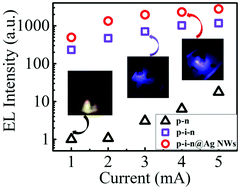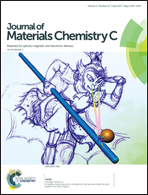Enhanced near-UV electroluminescence from p-GaN/i-Al2O3/n-ZnO heterojunction LEDs by optimizing the insulator thickness and introducing surface plasmons of Ag nanowires
Abstract
p-GaN/i-Al2O3/n-ZnO (PIN) heterojunction LEDs with different dielectric Al2O3 thicknesses were fabricated via an atomic layer deposition technique. By optimizing the i-Al2O3 layer thickness to be ∼12 nm, the effective electron accumulation and hole injection are simultaneously achieved in the n-ZnO active layer, resulting in a greatly improved near-UV electroluminescence intensity of this PIN type LED. Moreover, by introducing Ag nanowires, whose surface plasmon (SP) resonant energy is closer to the ZnO UV emission energy, into the LED structure, the electroluminescence intensity was further increased ∼2.8 times. Time-resolved and temperature-dependent spectroscopy analyses reveal that both the spontaneous radiation rate and internal quantum efficiency of the ZnO active layer are increased as a result of resonant couplings between ZnO excitons and Ag nanowire SPs, which gives rise to the observed near-UV electroluminescence enhancement.



 Please wait while we load your content...
Please wait while we load your content...